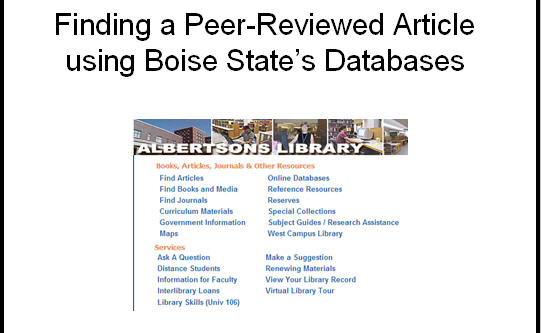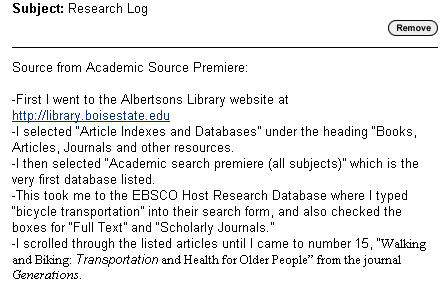Research Instruction at the Point of Need: Information Literacy and Online Tutorials
of Research Instruction
and
Tutorials
Teaching
Research
for
Designing Tutorials
Research Assignments and Tutorials
In this section, we present a research assignment and the tutorials that we developed to teach students how to find the information needed for these assignments. As you'll see, these are step-by-step assignments that lead students through the process of research for this specific assignment. We also include interviews with some of Boise State's faculty members to support our claims about research instruction.
Before describing the assignments and the tutorials, we must emphasize the importance of the collaboration between discipline faculty and librarians. It has become increasingly clear to us that to situate research contextually, it is imperative that those involved in the enterprise of teaching research—librarians and discipline faculty—work together to create the assignments and tutorials. Although librarians understand the variety of resources available, they do not generally develop assignments. Similarly, discipline faculty develop assignments, but they do not and should not be expected to know the variety of sources and strategies available. If collaboration between these two faculty members does not happen during the creation of the assignment, too often discipline faculty develop assignments with instructions that don’t quite make sense given the sources available to students and librarians create tours and tutorials that are too general. The importance of collaboration is discussed again in the next section of this essay.
In order to understand how current English 102 (the course in the first-year composition sequence that focuses on research) instructors teach research, Tom interviewed five instructors and received responses to a written survey from six instructors (2006). These ten instructors (one of the instructors whom Tom interviewed also submitted a survey) of the approximately sixty part-time instructors who teach this course were either asked personally by Tom to be interviewed or self-selected to respond to the survey, which was distributed digitally and in hard copy to all sixty instructors. These respondents, then, are all people who are highly motivated to participate in the administrative life of the department. They are all eager to learn new teaching strategies and to understand the possibilities afforded to students by digital technology.
Our study does not encompass observations of students after they complete our courses. As we note in The Challenges of Research Instruction, other studies note improved student performance as a result of tutorials that were incorporated into the class (Emurian, 2006; Larkin & Pines, 2005; Kelly, 2005; Hulls at al, 2005; Tsang & Chan, 2004) . Here, we rely on the change in students' ability to demonstrate that they've been able to access the various research sources that we've specified. These responses encourage us to believe that they are more proficient researchers, but we cannot conclusively demonstrate that they are able to apply these research skills in other contexts.
We began by revising an assignment that we found in the Lunsford and Ruszkiewicz (2004) text, Everything's An Argument:
| For examples of powerful evaluation arguments, search the Web or library for obituaries of famous, recently deceased individuals. Try to locate at least one such item and analyze the types of claims it makes about the deceased. What criteria of evaluation are employed? What kinds of evidence does it present? |
As we describe in "Competing Sources" (2007), we altered the assignment so students could become familiar with both free sources and subscription-databases offered in the virtual library of the college to find obituaries. We gave specific procedures for accessing the online database Academic Search Premier in the Boise State University virtual library. Now the assignment read:
| Before you respond to question 6, take a look at the PowerPoint that’s posted under Course Documents. I’m going to ask you to write a brief comment on the differences you noticed between the various ways of accessing this information. You can include this in your answer to question 6. In other words, I want you to look up an obituary through the virtual library and the Internet, and describe the differences. |
The PowerPoint presentation (which we encourage readers of this article to adapt to their own needs) provides students with step-by-step instructions of how to access the virtual library.
 |
We also added a Camtasia animation, so that students would have more than one way to access the instructions.
 |
As we describe in the Instructors Teaching Research section of this article, the step-by-step instructions that we provide here are replicated again and again by composition instructors and librarians across campus. What’s different about what’s usually available and what we produced is that ours were relatively easy and inexpensive to put together (PowerPoints and animations) and were delivered with the assignment. Though the tutorials stand on different platforms, they normally provide the same instructions. In this article, however, we have included the PowerPoint we used to introduce the difference between free and fee-based sources, but, instead of linking to a Camtasia presentation of the same subject, we have used instead a Camtasia animation that directs students to use a fee-based resources. We used tutorials that address different subjects in order to demonstrate a few of the ways that they can be constructed.
Presenting the same materials on different platforms, however, was extremely useful for students. As we anticipated, some students preferred the PowerPoint, while others preferred the animation. As we moved through several assignments that provided students with basic PowerPoint tutorials that asked them to specifically try different kinds of online sources, students moved from using a search engine as their sole means of research, to using the search engine and the database as the result of a more specific assignment and the addition of research logs.The research log proved to be the linchpin of the assignment. We added this requirement as a last resort when students, having been provided with tutorials and instructed to perform different research tasks, simply didn't do the research as instructed but instead relied on general Google searches. The research logs, which require students to record each step of their research process, provided us with the means to knowing exactly what they had done. Our persistent checking of the research log, followed by immediate feedback in the form of re-iterated demands, resulted in students widening their research repertoire.
 |
Our experience also suggests that while instructors and librarians need to provide detailed instruction to local resources, those instructions don’t have to be elaborate. A fairly simple PowerPoint, to which we referred students repeatedly, and posting the instructions on the first screen the students saw on the course Web site, was sufficient to our needs. The key point of the instructional material was that it served students at their points of need; they were able to find specific resources as directed.